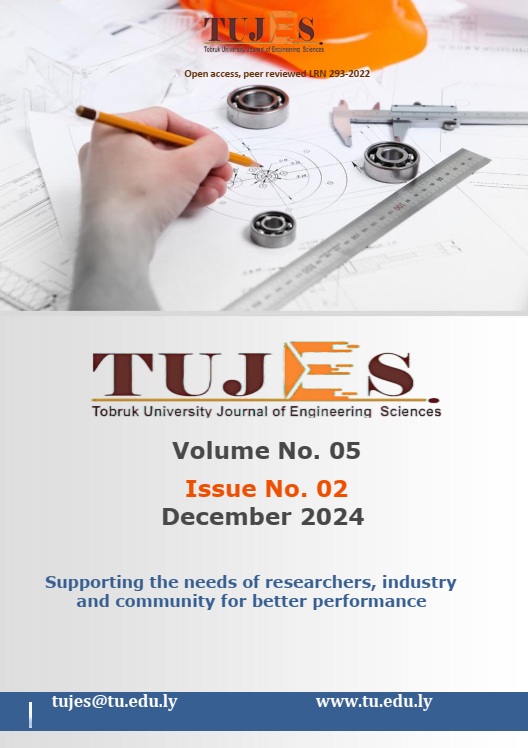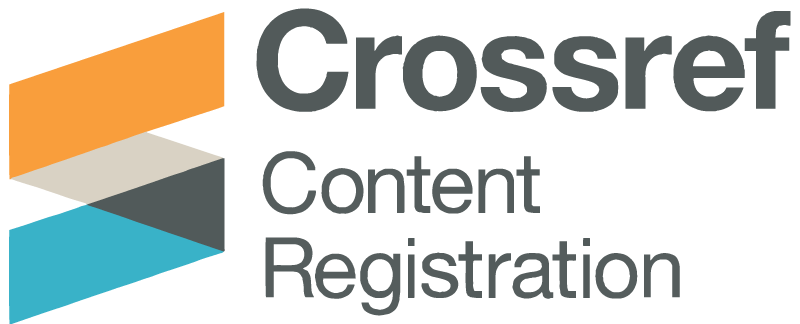Developing New PVT Correlations for the Libyan Crude Oil Using Samples from Different Reservoirs
DOI:
https://doi.org/10.64516/jk6pe712Keywords:
PVT, Empirical Correlations, bubble point pressure, oil density, LibyaAbstract
Five PVT correlation include bubble point pressure, solution gas oil ratio, oil formation volume factor, dead oil viscosity and oil density were used to analyze a total of 102 data sets from the Libyan crude oil reservoirs representing Sirte, Ghdames, Murzug and offshore Tripolitania basins, to find anew more accurate correlations. Linear & nonlinear regression and statistical software package (Excel, Minitab and Mat lab software) were applied on the above -mentioned crude samples. The application of multilinear regression and a statically software on the solution gas, oil ratio, temperature and API gravity, exhibit a direct proportional with the bubble point, where as in the case of gas gravity the correlation show inversely proportional with the bubble point. The relationships between the solution gas oil and other properties show that the distribution of the tested points in these investigations are located very closet the 45° trend line for the solution gas oil ratio, indicating that the correlations have a higher accuracy with our new developed PVT equations for the analyzed Libyan crude oil samples. The cross plots between measured vs. calculated oil formation factor, dead oil viscosity and oil density is play a very good reliable correlation compared with previous published correlations done by other researchers as well as in the statistical calculation, in addition the AARE and R2 results were calculated for previous published correlation in different locations over the world. Based on the obtained results in this research, the proposed correlations are more accurate than all the other previous published correlations, exclusively for the Libyan crude oil.
References
Abdul-Majeed G. H. and Salman N. H. (1988) An empirical correlation for oil FVF production. Journal of
Canadian Petroleum Technology. 27(6): 118-122.
Ahmed T. H. (2007) Equations of state and PVT Analysis: Applications for Improved Reservoir Modelling.
Gulf Publishing Company, Houston, Texas.
Al-Marhoun M. A. (1988) PVT Correlations for Middle East crude oils. Journal of Petroleum Technology. 40(05):650-666.
Al-Mehaideb R. (1997) Improved PVT correlations for UAE offshore crudes. Journal of the Japan Petroleum Institute. 40(3):232-235.
Al-Shammasi A. A. (1999) Bubble point presure and oil formation volume factor correlations. In : Middle East Oil show and conference . Society of Petroleum Engineers. Bahrain. Paper SPE 53185.
Araps J. J. (1962) Estimation of Primary oil gas reservoir. Rick. T. C. Petroleum Production handbook. V(2) Dallas. SPE. Chapter 37, P.1.
Beal C. (1946) The viscosity of air, water, natural gas, crude oil and its associated gases at oil field temperatures and pressures. Transactions of the AIME. 165(01): 94-115.
Beggs H. D. and Robinson J. (1975) Estimation the viscosity of crude oil systems. Journal of Petroleum Technology. 27(09):1140-1141.
Bergman D. (2004) Don't forget viscosity. Petroleum Technology Transfer Council 2nd Annual Reservoir Engineering Symposium. Lafayette, Louisiana.
Business Monitor International (BMI) (2018) Research Libya Oil and Gas Report Includes 10-year forecasts to 2027. Fitch Group Company, Report Q 2nd 2018.
Danesh A. (1998) PVT and phase Behavior of Petroleum Reservoir Fluids. Scotland. Elsevier.
De Ghetto G., Paone F. and Villa M. (1995) pressure -volume- temperature correlations for heavy and extra heavy oils. In: SPE International Heavy Oil Symposium. Society of Petroleum Engineers.
Dindoruk B. and Christman P. G. (2001) PVT properties and viscosity correlations for Gulf of Mexico oils. SPE Annual Technical Conference and Exhbitation. Society of Petroleum Engineers.
Dokla M. and Osman M. (1992) Correlation of PVT Properties for UAE crudes (includes associated papers 26135 and 26316). SPE Formation Evaluation. 7(01): 41-46.
El-Hoshoudy, A. and Desouky, S. (2019) PVT Properties of Black Crude Oil. Research Gate.
Elksharkawy A.and Alikhan A. (1999) Model for predicting the viscosity of Middle East crude oils. Fuel. 78(8): 891-903.
Elsharkawy A. and Gharbi R. (2001) Comparing classical and neutral regression techniques in modeling crude oil viscosity. Advanced in Engineering Software. 32(3): 215-224.
Frashad F., Leblanc J., Garber J. and Osorio J. (1996) Empirical PVT correlations for Colombian crude oils. In: SPE Latin America / Caribbean Petroleum Engineering Conference. Society of Petroleum Engineers.
Glaso O. (1980) Generalized pressure- volume- temperature correlations. Journal of Petroleum Technology. 32(05):785-795.
Hanafy H. Macary S. EI-Nadyet Y. Bayomi A. and Batanony M. (1997) Empirical PVT correlations applied to Egyptian crude oils exemplify significance of using regional correlations. In: International Symposium on Oil field Chemistry. Society of Petroleum Engineers.
Hemmati M. N. and Kharrat R.A. (2007) Correlation approach for prediction of crude oil PVT properties. In: SPE Middle East Oil and Gas Show conference. Society of Petroleum Engineers.
Hossain M.S. Sarica C. Zhang H. Q. Rhyne L. and Greenhill K. (2005) Assessment and development of heavy oil viscosity correlations. In: SPE International Thermal Operations and heavy Oil Symposium. Society of Petroleum Engineers.
Ikiensikimama S. Egbe T. Effiong E. and Ogboja O. (2008) New screening technique for PVT correlations as applied to the Niger Delta crude. In: Refereed Proceedings.
Jarrahian A. Moghadasi J. and Heidaryan E. (2015) Emperical estimating of black oils bubble point ( saturation) pressure. Journal of Petroleum Science and Engineering. (126):69-77.
Jellah, A. I. (2018) Reservoir Fluids Properties Module. unpublished material notes at oil and Gas Engineering Department, Bani Walied University, Libya.
Kartoatmodjo T. and Schmidt Z. (1994) large data bank improves crude physical property correlations Oil and Gas Journal. (United States). 92(27).
Kaye S.(1985) Off shore California viscosity correlations. COFRC, TS85000940.
Khamechi E. Rashidi F. Rasouli H. and Ebrahimian A. (2009) Novel empirical correlations for estimation of bubble point pressure, saturated viscosity and gas solubility of crude oils. Petroleum Science. 6(1):86-90.
Khazam, M. M. (1995) Statistical Evaluation and Optimization of PVT Correlations for Libyan Crudes, National Oil Corporation NOC, Tripoli Libya.
Khazam M, Shlak M, Alkhaboli M (2016) New PVT Correlations Based on Libyan Crudes for Predicting Fluid Physical Properties. Oil Gas Res 2: 122
Labedi R. M. (1992) Improved correlations for predicting the viscosity of light crudes. Journal of Petroleum Science and Engineering. 8(3): 221-234.
Labedi R. M. (1990) Use of prediction data to estimate the saturation pressure, solution GOR, and chemical composition of reservoir fluids. In: SPE Latin America Petroleum Engineering Conference. Society of Petroleum Engineers.
Levitan L.L. and Murtha M.(1999) New correlations estimate PH, FVF. Oil and Gas Journal 79(10):10.
Marcary S. and El-Batanoney M. (1993) Derivation of PVT correlations for the Gulf of Suez crude oils. Journal of the Japan Petroleum Institute. 36(6): 472-478.
Mazandarani M. T. and Asghari S. M. (2007) Correlations for predicting solution gas-oil ratio, bubble point pressure and oil formation volume factor at bubble point of Iran crude oils. In: European Congress of Chemical Engineering (ECCE-6). PP16-20.
Naseri A., Yousefi S., Sanaei A. and haresheikhlou A.A.(2012) Neutral network model and an updated correlation for estimation of dead crude oil viscosity. Brazilian Journal of Petroleum and Gas. 6(1).
Ng and Egbogh E. ( 1983) An improved temperature- viscosity correlation for crude oil systems. In: Annual Technical Meeting. Petroleum Society of Canada.
Omar M. and Todd A. ( 1993) Development of new modified black oil correlations for Malaysian Crudes. In: SPE Asia Pacific Oil and Gas Conference. Society of Petroleum Engineers.
Oyedeko K. F. and Ulaeto U. W. (2001) Predicting the dead oil viscosity of reservoir fluids: A case study of Niger Delta. Journal of Energy Technology and Policy. (3): 1-7.
Petrosky G. Jr. and Farshad F.(1995) Viscosity correlations for Gulf of Mexico crude oils. In: SPE Production Operation Symposium. Society of Petroleum Engineers.
Petrosky J. G. and Farshad F. (1993) Pressure - volume- temperature correlations for Gulf of Mexico crud oils. In: SPE Annual Technical Conference and Exhibition. Society of Petroleum Engineers.
Shlak M., Khazam, M. and Alkhaboli M. (2016) New PVT Correlations for Libyan crudes Icc page-Al Mergib University, Alkhoms, Libya
Downloads
Published
Issue
Section
License
Copyright (c) 2024 Journal of Engineering Sciences

This work is licensed under a Creative Commons Attribution 4.0 International License.













